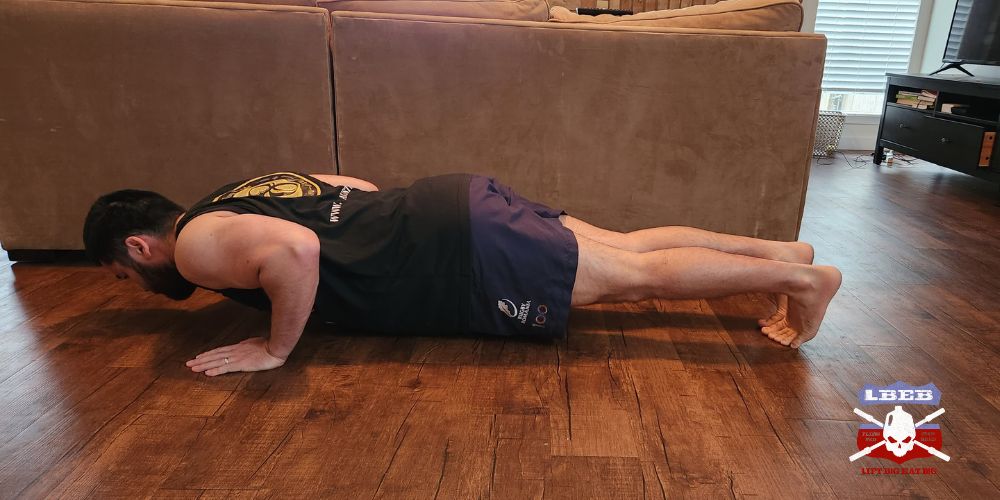The push-up has been replaced with bench press and chest press machines. It’s sad. A once glorified upper body mass builder benched for inferior exercises. But are push-ups an effective muscle builder?
Push-ups build the chest, shoulders, and triceps muscles. Depending on the push-up variation, you can target the chest or triceps to a greater degree.
But how many push-ups should you do, and what is the best push-up to build muscle?
Table of Contents
Do Push-Ups Build Muscle?
Push-ups build upper body muscles of the chest, shoulders, and triceps. By changing your hand width, you can prioritize the chest or triceps. For example, a narrow hand width elicits greater triceps activation than a wide hand width known as the triceps push-up [1][2].
Therefore, a wider hand position preferentially targets the chest. The push-up is an excellent muscle builder because of the mechanical tension placed on these muscles. Mechanical tension is maximized through force generation and stretch [3][4][5].
The chest, shoulders, and triceps are stretched during the lowering (eccentric) phase before shortening during the upward (concentric) phase.
Increasing force generation requires loading, and increasing stretch requires a full range of motion. However, to improve the muscle-building response with the bodyweight push-up, you can do them close to or to failure, as lifting lighter loads at these intensities also maximizes mechanical tension [6].
How Many Push-Ups A Day To Build Muscle?

There is no set number of push-ups per day to build muscle. It depends entirely on your level of fitness and training program. If you struggle to perform a set of 10 push-ups, then 2-3 sets of 7-9 push-ups will help build muscle.
You’ll need far more reps if you can pump multiple 20+ rep sets of push-ups. Typically, 50 – 100 reps per day is what I recommend. However, you don’t need to perform push-ups daily to build muscle. Once to twice a week of horizontal pushing is more than enough to stimulate muscle growth.
But daily push-ups can be a tool to add extra volume that’s easy to recover from. For example, you could perform 50 -100 reps daily, avoiding failure.
How Many Reps Of Push-Ups To Build Muscle?
Within a workout, you want to perform enough reps to be close to or at failure to maximize the muscle-building response. However, if you are very strong and can perform 20+ reps, reaching this point can take too long.
To make it so you reach close to failure before 20 reps, you can use intensity techniques to fail faster. For example, supersetting the bench press with the push-up pre-fatiguing the same muscles reduces the number of reps you can do.
Another option is to add a load with bands or plates. You can also increase the range of motion by elevating your hands on plates or boxes.
Best Push-Up To Build Muscle
Weighted Push-Up
The weighted push-up is the best variation to build muscle. To increase force generation, enhancing mechanical tension. You can do this with a few different methods:
- Add plates on your back (requires a partner)
- Use a resistance band
- Elevate your feet
Adding plates is the best option in my experience, but it requires a partner, especially when stacking multiple plates. You’re doing an upside-down bench press, packing muscle onto your upper body. The band is the second-best option which can easily be done solo.
The disadvantage compared to plates is the bottom position isn’t loaded, which is where you want the extra load to place tension under long muscle lengths. However, it will still significantly tax your chest, shoulders, and triceps.
Finally, if you have no equipment, you can elevate your feet. Doing so places more weight over your arms, increasing the force generated by the pressing muscles [7].
To turn the weighted push-up into a more potent muscle builder, increase the range of motion by elevating the hands. This, combined with added load, makes this an excellent upper-body muscle builder.
Summary
Push-ups build muscle and are an underutilized exercise in favor of fancy machines. Daily push-ups are a method to add more pressing volume without a lot of fatigue but aren’t necessary. Add weight and increase the range of motion to maximize muscle growth with the push-up.
References
1. Batbayar, Y., Uga, D., Nakazawa, R., & Sakamoto, M. (2015). Effect of various hand position widths on scapular stabilizing muscles during the push-up plus exercise in healthy people. Journal of physical therapy science, 27(8), 2573-2576.
2. Cogley, R. M., Archambault, T. A., Fibeger, J. F., & Koverman, M. M. (2005). Comparison of muscle activation using various hand positions during the push-up exercise. Journal of strength and conditioning research, 19(3), 628.
3. Schoenfeld, B. J. (2010). The mechanisms of muscle hypertrophy and their application to resistance training. The Journal of Strength & Conditioning Research, 24(10), 2857-2872.
4. Wackerhage, H., Schoenfeld, B. J., Hamilton, D. L., Lehti, M., & Hulmi, J. J. (2019). Stimuli and sensors that initiate skeletal muscle hypertrophy following resistance exercise. Journal of applied physiology.
5. Krzysztofik, M., Wilk, M., Wojdała, G., & Gołaś, A. (2019). Maximizing muscle hypertrophy: a systematic review of advanced resistance training techniques and methods. International journal of environmental research and public health, 16(24), 4897.
6. Schoenfeld, B. J., Grgic, J., Ogborn, D., & Krieger, J. W. (2017). Strength and hypertrophy adaptations between low-vs. high-load resistance training: a systematic review and meta-analysis. The Journal of Strength & Conditioning Research, 31(12), 3508-3523.
7. Ebben, W. P., Wurm, B., VanderZanden, T. L., Spadavecchia, M. L., Durocher, J. J., Bickham, C. T., & Petushek, E. J. (2011). Kinetic analysis of several variations of push-ups. The Journal of Strength & Conditioning Research, 25(10), 2891-2894.
